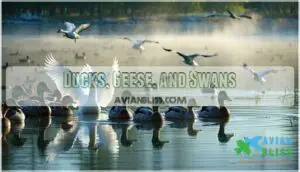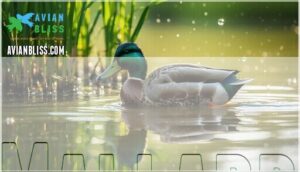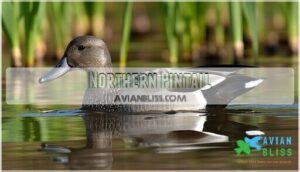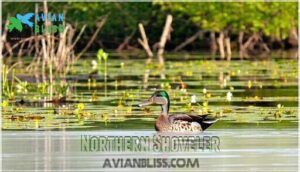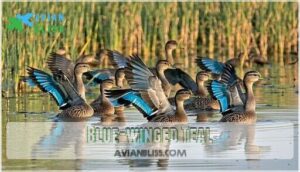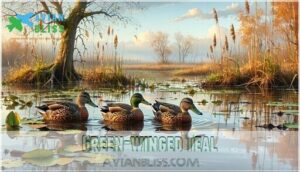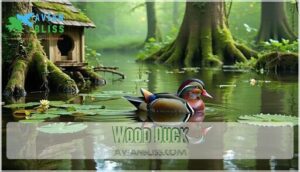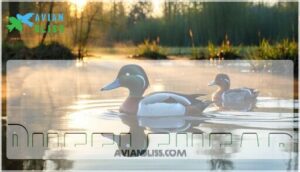This site is supported by our readers. We may earn a commission, at no cost to you, if you purchase through links.

The Great Lakes and thousands of inland waters create perfect habitat for ducks, geese, and swans year-round.
Spring and fall migrations bring the real show, when species like northern pintails and blue-winged teal join the party.
Wood ducks nest in tree cavities near wooded wetlands, while buffleheads prefer deeper waters where they can dive for small fish, showcasing how each species has adapted to Michigan’s diverse aquatic environments in fascinating ways.
Table Of Contents
- Key Takeaways
- Ducks, Geese, and Swans
- Mallard
- American Wigeon
- Northern Pintail
- Northern Shoveler
- Blue-winged Teal
- Green-winged Teal
- Wood Duck
- Bufflehead
- Hooded Merganser
- Frequently Asked Questions (FAQs)
- What Michigan bird dives into the water?
- What kind of birds hang around water?
- What is the black Michigan water bird?
- Are Anhingas in Michigan?
- When is the best time to observe herons?
- How deep can Common Loons dive underwater?
- What threats do Trumpeter Swans face today?
- Where do Sandhill Cranes build their nests?
- Why are Mute Swans considered invasive species?
- Conclusion
Key Takeaways
- You’ll find over 40 species of water birds in Michigan, with the Great Lakes and inland waters creating ideal habitats year-round.
- Migratory ducks like northern pintails and blue-winged teal pass through Michigan during spring and fall, showcasing incredible adaptations.
- Birds like wood ducks and buffleheads rely on specialized habitats like tree cavities and deeper waters for nesting and feeding.
- Conservation efforts, such as wetland restoration, are crucial to protecting Michigan’s water birds from threats like habitat loss and pollution.
Ducks, Geese, and Swans
If you’ve ever watched Michigan ducks dabbling in a pond or heard Michigan geese honking in perfect V-formation, you’ve glimpsed the charm of waterfowl life. Ducks, geese, and Michigan swans form a vital part of avian ecosystems, with unique behaviors that keep things interesting.
Did you know swan aggression can rival a goose’s territorial honks? Mute swans, for instance, defend up to 8 pounds of aquatic plants daily, while Canada geese return loyally to nesting spots year after year, mastering goose migration challenges.
Meanwhile, snow geese gorge on crops during stopovers—like marathon runners carb-loading for long trips. Duck adaptations shine in winter when mallards dabble for aquatic plants or gracefully lead waterfowl formations south. Their waterproof feathers are coated with oil.
Whether ensuring waterfowl conservation or marveling at these feathered friends, understanding their survival dances enriches your connection to Michigan’s wetlands. After all, who can resist their quirky charm?
Mallard
What makes mallards so enchanting? These Michigan ducks are everywhere—ponds, rivers, even the occasional roadside puddle—and they’re not shy about flaunting their distinct personalities.
The male mallard’s iridescent green head and chestnut chest stand out, especially during courtship when he’s at his flashiest. Females, on the other hand, rock more practical, mottled brown feathers for blending into nesting spots.
Mallard behavior is fascinating to watch. Dabbling—tipping forward in shallow water—is their trademark style for grabbing underwater plants, insects, and seeds. They’re not picky eaters, making them highly adaptable to various environments.
During breeding season, their diet shifts to include more animal matter to support higher energy demands. Although still abundant, Michigan waterfowl like mallards face challenges.
Habitat loss threatens their wetlands, and conservation efforts are vital to protecting this iconic species. Whether you’re birdwatching or just enjoying Michigan’s lakes, mallards are a familiar, delightful presence.
American Wigeon
From the flashy mallard to the charming American wigeon, Michigan waterfowl have plenty to impress. This dabbling duck, nicknamed the "baldpate" for the bold white crown on males, is a favorite among Michigan birdwatching enthusiasts.
During Wigeon Migration, these elegant water birds stop at wetlands, lakes, and flooded fields across the state, treating birders to a display of their stunning Wigeon Plumage.
Wigeon Habitat includes areas rich in aquatic plants, which dominate the Wigeon Diet alongside small invertebrates. You’ll often see them tipping forward, skimming the surface alongside their flock.
Their emerald eye patches and chestnut plumage make spotting them a delightful challenge. But populations face pressure from habitat loss. Efforts like wetland restoration are critical for Wigeon Conservation, ensuring future generations can enjoy these Michigan water birds.
Keep an eye out during migration seasons—nature’s showstopper awaits! They’re highly gregarious outside of breeding season.
Northern Pintail
The Northern Pintail is like nature’s sleek jet fighter among Michigan water birds.
You’ll spot their streamlined appearance—males flaunting chocolate heads, white breasts, and elegant tail feathers.
These agile flyers are dabbling ducks, often seen in shallow wetlands or performing exciting courtship displays mid-flight.
With a bittersweet connection to Michigan, they rest here briefly during migration, heading north to breed.
Habitat loss has challenged this waterfowl species, but wetland conservation offers hope for their future.
Notably, some birds like the white crowned sparrow also migrate through similar regions.
- Traits to Watch:
- Chocolate-brown head and neck
- Long, tapering tail feathers
- Graceful V-shaped flight flocks
- Shallow wetland gatherings
- Energetic aerial courtship displays
Northern Shoveler
If you thought Northern Pintails were graceful, wait until you spot a Northern Shoveler. These medium-sized ducks are hard to miss with their oversized, spoon-shaped bills – a tool that’s perfect for filter feeding on tiny invertebrates in Michigan’s wetlands.
You’ll often find them paddling in shallow, stagnant pools, their heads bobbing as they strain water for food. Males sport a striking green head and chestnut sides, while the more camouflaged females stick to mottled browns.
Spring is a lively time, with Shovelers performing quirky courtship displays. They prefer similar habitats to the cavity nesting wood duck.
Protecting Michigan’s bird habitats keeps these shovel-billed wonders thriving. Keep an eye out – they’re nature’s comedians with a knack for making filtering look fun!
Blue-winged Teal
While Northern Shovelers flaunt their spoon-shaped bills, Blue-winged Teal captivate Michigan bird enthusiasts with their graceful summer visits.
These petite water birds, easily spotted during Teal Migration, prefer shallow Wetland Habitats for nesting and feeding.
Known for their distinct Teal Identification—blue shoulder patches and crescent-shaped face markings—they bring a splash of color to Michigan’s water bird community.
Their Teal Diet includes aquatic vegetation and invertebrates, making them frequent diners in Michigan’s ponds and marshes.
Thanks to ongoing Conservation Status protections and wetland preservation, their population thrives.
Spotting these elegant Blue-winged Teal reminds us how Michigan fosters its rich bird species diversity.
During breeding season, males showcase a cinnamon-colored head.
Green-winged Teal
In spotting water birds in Michigan, the Green-winged Teal stands out as both elegant and tiny.
As the smallest dabbling duck in North America, its distinct green eye stripe and shimmering green wing patches make identification a breeze.
You’ll often see them in Michigan’s shallow wetlands and ponds during migration, picking seeds and aquatic insects from the surface—a key part of their teal diet.
These petite ducks are early arrivals in spring and among the first to migrate south by late fall.
Watching their journey reminds us of the beauty in nature’s rhythms.
Their squeaky whistles and sharp flight calls bring life to Michigan bird habitats, even as seasons shift.
Teal conservation efforts focus on maintaining wetlands, as healthy habitats are vital for their survival.
Next time you visit a marsh, pause—you might glimpse their vivid beauty darting through the reeds.
They’re known to reach flight speeds up to 50mph.
Wood Duck
If you’re exploring Michigan’s wooded wetlands, keep an eye out for the stunning Wood Duck. Males boast unique plumage with iridescent greens, chestnut tones, and bold white markings, while females sport softer brown patterns.
They rely on tree cavities for nesting and show a remarkable bond with forests near water. They’re excellent swimmers, but typically prefer surface dabbling for food.
Listen for their subtle whistling wings during migration in March, or spot females leading ducklings through marsh grasses in late summer. Despite being the most abundant breeding duck in eastern North America, they need protection due to habitat loss.
- Habitat: Prefer wooded wetlands in Michigan bird habitats near slow-moving water.
- Nesting Habits: Females use down feathers to line nests in high tree cavities.
- Diet Analysis: Enjoy acorns and aquatic plants.
- Conservation Status: Stable, thanks to wetland restoration efforts.
Bufflehead
Michigan’s smallest diving duck makes quite the impression with its distinctive black-and-white plumage variations.
You’ll spot buffleheads bobbing energetically in lakes and bays during winter months, their buoyant nature making them seem almost unsinkable.
These chunky little water birds showcase impressive diving abilities, disappearing beneath the surface for 12-20 seconds while hunting aquatic invertebrates.
Bufflehead behavior includes rapid head-bobbing courtship displays that’ll make you chuckle.
Males sport that eye-catching white patch behind their heads, while females wear subtler gray-brown feathers with white cheek patches.
Their habitat preference leans toward depths of 1.2 to 4.5 meters in Michigan’s Great Lakes region.
Like the bufflehead, the wood duck favors cavities for nesting.
Thanks to stable conservation status and adaptable nesting habits in tree cavities, these Michigan bird species continue thriving.
You’re witnessing nature’s small miracle when buffleheads return as ice melts each spring.
Hooded Merganser
You’ll easily pick out the hooded merganser by its fan-shaped white crest that pops up like a mini mohawk.
These diving ducks are among Michigan’s most distinctive water birds, with males sporting striking black-and-white plumage that’s hard to miss.
Their conservation status remains stable thanks to successful nest box programs throughout the state.
Watch their impressive diving behavior as they chase fish and crayfish underwater using serrated bills.
The male plumage becomes even more dramatic during breeding season when courtship displays begin.
Females prefer nesting habits that involve tree cavities near wooded wetlands.
Their hooded merganser diet consists mainly of aquatic prey they catch while diving.
You’ll find these Michigan bird species in calm ponds and marshes year-round, making Michigan bird identification easier when you spot that unmistakable collapsible crest cutting through the water.
They favor calm bodies of water, particularly those with wooded swamps.
Frequently Asked Questions (FAQs)
What Michigan bird dives into the water?
Brilliant blue Belted Kingfishers dive headfirst from perches to catch fish.
While Common Loons plunge underwater for minutes, reaching depths of 250 feet.
You’ll also spot Double-crested Cormorants expertly diving in Michigan’s waters.
What kind of birds hang around water?
You’ll spot herons, egrets, ducks, and cormorants hanging around water bodies.
These birds love shallow lakes, rivers, and marshes, diving for fish, wading through reeds, or floating gracefully on the surface, each with unique hunting strategies.
What is the black Michigan water bird?
You’ll find several black water birds in Michigan, including Double-crested Cormorants with their hooked bills.
Black-crowned Night Herons prowling wetlands, and sleek American Coots with distinctive white bills diving through lake waters.
Are Anhingas in Michigan?
Like a rare wandering spirit, anhingas occasionally drift into Michigan’s landscape—a surprising visitor from warmer climates.
While not native residents, these "devil birds" have been spotted, making their unexpected appearance a thrilling moment for bird enthusiasts, especially when considering the rare occurrence of such sightings.
When is the best time to observe herons?
The best time to watch herons is early morning or late evening during spring and summer.
They’re most active hunting fish in wetlands then, and the soft light adds a magical glow to their graceful movements.
How deep can Common Loons dive underwater?
Common Loons are amazing divers, plunging as deep as 250 feet underwater.
It’s like they’re the scuba experts of the bird world, staying submerged for several minutes while hunting fish with incredible precision!
What threats do Trumpeter Swans face today?
Trumpeter Swans face threats like habitat loss, pollution, and lead poisoning from ingesting hunting ammunition.
Human activities, including lakefront development and oil spills, disrupt their nesting areas.
Climate change adds stress, challenging their survival and migration patterns.
Where do Sandhill Cranes build their nests?
Like architects of wetlands, Sandhill Cranes build their nests in shallow marshes or bogs, crafting floating platforms of vegetation.
These precise structures keep their eggs safe from predators and guarantee the nests stay afloat.
Why are Mute Swans considered invasive species?
Mute Swans are considered invasive because they outcompete native waterfowl for resources, destroy wetland habitats by overfeeding, and aggressively displace other species.
Their demand for up to 8 pounds of vegetation daily disrupts ecosystems substantially.
Conclusion
Exploring water birds in Michigan is like opening a living biology book, with each species offering a glimpse into nature’s ingenuity.
From the graceful trumpeter swan to the quirky northern shoveler, every bird showcases fascinating adaptations to Michigan’s wetland habitats.
Whether you’re captivated by the vibrant wood duck or awed by diving buffleheads, there’s always something remarkable to discover.
So grab some binoculars, head to the water’s edge, and let Michigan’s water birds wow you year-round!

